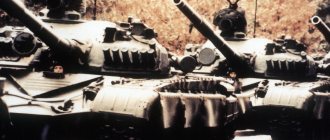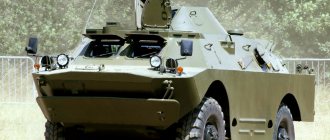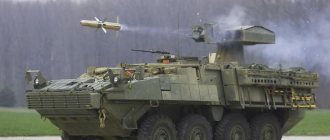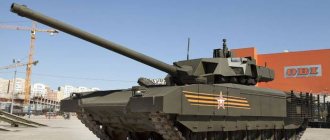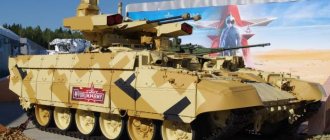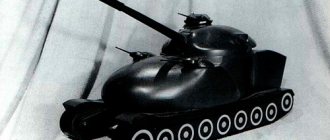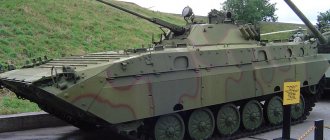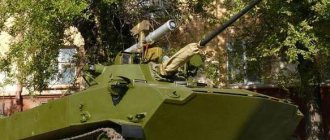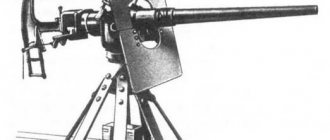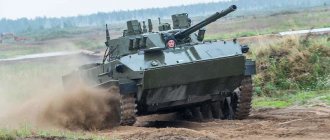The history of the creation of the armored repair and recovery vehicle Bergepanther
Soon after the formation of the first battalions of Tiger and Panther tanks, it became clear that the Wehrmacht did not have the necessary tractors to evacuate damaged heavy tanks. It got to the point of absurdity - almost serviceable tanks with minor damage to the chassis had to be abandoned during the retreat, because moving an immobilized fifty-ton giant was absolutely not an easy task.
The standard 18-ton FAMO tractor was well suited for evacuating medium tanks Pz-III and Pz-IV, but it was clearly not enough for towing Tigers and Panthers. Thus, to evacuate one Tiger, three 18-ton tractors had to be connected at once tractor! But even with such consumption, the game was not worth the trouble - tractors not designed for such a load often broke down.
Therefore, by June 6, 1943, MAN was tasked with urgently developing an armored repair and recovery vehicle of increased power, with a name to match its future “clients”: the Bergepanther BREM .
Officially, the technical specifications were published only on May 7, 1943 (a month before delivery), and the Henschel company received an order ahead of schedule for the production of 70 Bergepanthers. Naturally, we were not talking about development “from scratch”. The ARV was based on the chassis, hull and engine from the same heavy tank Pz.V “Panther”. However, even without this, the designers had enough problems.
Drawing of BREM Bergepanther Sd.Kfz.179
Equipment of the Bergepanther repair and recovery vehicle
The main problem in creating the Bergepanther was the development of a winch with a force of 40 tons and capable of pulling a load over a distance of 150 meters. The Germans did not have such winches. It was only in 1940 that a similar winch was developed for the amphibious SpezialPionerfahrzeug (special purpose engineer vehicle), which, among other capabilities, could destroy road surfaces and also remove artificial barriers. Two prototypes were produced in the autumn of 1941, based on the 8-wheel Einheitsdiesel . The winch installed on the prototype pulled the share at a speed of 10 meters per minute. To hold the car in place, a stop was installed at the stern. The tests were successful, but the car never went into production.
The winch for the "Bergepanther" at MAN was created according to the same principle, but had several design features caused by the need to be placed inside the "Panther" hull. Structurally, the winch was not like other models installed on machines of this class. The winch had eight rollers located on two shafts. The cable was stretched between the rollers and wound onto a drum placed behind them. The winch took power through the transfer case from the tank engine. The design of the winch turned out to be quite complex, which led to further problems. The fact is that manufacturers capable of producing such complex products were already too overloaded with work. Therefore, it was not possible to produce winches in the required quantity, and because of this, not all Bergepanthers were equipped with these winches.
The winch was placed inside the engine compartment and covered with an awning on top. A stop was installed at the stern that fixed the machine while the winch was operating. To evacuate the damaged Bergepanther tank, it stopped 100 meters from it, wound up the tow rope, and lowered the stern stop. With the help of a winch, the damaged tank was pulled up to the Bergepanther, after which the stop was raised and the Bergepanther drove off the next 100 meters, and the operation was repeated until the tank was removed from under fire.
At the top of the Bergepanther body there was a guide device consisting of two vertical and two horizontal rollers. Thanks to the guide device, the cable was wound onto the drum much more smoothly. The car was equipped with a dynamometer, so it was possible to control the tension of the tow rope.
Technical tests of the "Bergepanther" were carried out at the Kumersdorf training ground. Engineer Major Wüst supervised the tests. After it was possible to eliminate all the problems in the operation of the winch, its design was considered satisfactory, and the design as a whole was considered successful.
The lack of a crane on the machine caused some objections. A special two-ton crane was created in the Kumersdorf workshop, which could also be installed on a regular Panther. The crane was installed in three slots on the roof armor of the Panther turret; the crane rotated 360 degrees. The "Bergepanther" did not have a turret and therefore the crane only rotated 120 degrees.
Initially, criticism was caused by the way the towing cable was attached to the towed tank. During testing of different types of fastenings, it turned out that there is nothing better than a regular pin. In the end, the designers managed to satisfy all, even the most whimsical wishes for the design of the Bergepanther.
Despite the good grip on the ground, special teeth were designed that were screwed onto the tracks; to do this, the tracks had to be changed since ordinary panther tracks did not have holes for attaching bolts. Tests of these teeth gave the most positive results. In addition, they could just as easily be installed on conventional tanks. However, these teeth were never used in combat conditions.
BREM Bergepanther Sd.Kfz.179 evacuates the heavy tank Pz.VI "Tiger". Eastern front
Testing and production of the Bergepantera ARV
"Bergepanther" could not only pull, but also push tanks that had lost momentum. To do this, two square stops were placed in the bow of the vehicle, and the Bergepanther itself was equipped with a wooden beam transported on the left side.
The Bergepanther's tasks were not limited to towing and evacuation of damaged tanks. "Bergepanther" could be used as a mobile workshop, for transporting goods, and even as a mobile power generator. Many devices were developed for the Bergepanther to make standard operations easier: repairing the track tension mechanism, a jack for replacing road wheels, and kits for replacing a shot off drive wheel.
On March 1, the Bergepanther was demonstrated to the Inspector General of the Panzerwaffe, Colonel General Guderian. The demonstration took place at the Burke training ground near Eisenach.
On April 7, Hitler was informed about the good performance characteristics of the new BREM and was shown several photographs. Additionally, the Fuhrer was informed that the monthly production of Bergepanthers was 20 vehicles. In addition, it was planned to convert a number of disabled Panthers into Bergepanters. Although tank battalions sometimes independently removed the turrets from damaged Panthers, thus turning them into ammunition carriers and ARVs.
The production of 40-ton winches was carried out by Raupach (Gerlitz). Later, the production of winches was moved to a new plant in Varnsdorf. 20-30 winches were produced monthly.
The Bergepanther Ausf.A (Sd.Kfz.179) ARVs themselves were produced on the basis of the standard Pz.V. tank chassis, to the design of which only minimal changes were made.
The crew members' seats were located in the front of the vehicle. At the front there was a mount for a 20 mm cannon intended for self-defense. The gun was covered with an armor shield. Mounts for anti-aircraft machine guns were installed in the front of the hull on the left and right. All cars were equipped with a radio station. The capacity of the fuel tanks increased to 1075 liters. The body was produced by Ruhrstahl from Göttingen.
Since October 1944, "Bergepanthers" began to be produced on the basis of the Ausf.G chassis. The production of this modification continued until the end of the war. In addition to the Henschel company, the Bergepanter was produced by the Demag Werk Dusseldorf-benrath company.
A total of 297 vehicles were produced, 46 of them without a winch.
The creation of a tank tractor based on the T-54 was entrusted to the design bureau of plant No. 183 back in July 1947. But the plant, due to the refinement of the design of the base vehicle and the organization of its mass production, began this work only in November 1957. The technical design of the tractor was completed in December of the same year, after which it was sent for consideration to the Ministry of Transport Engineering. Until July 1948, the project was being finalized.
Experienced tank tractor "Object 9" with a deployed boom crane with a lifting capacity of 3 t.
Installation of a 7.62-mm Kalashnikov assault rifle with a curved barrel in a ball joint in the roof of the Object 9 housing.
However, due to a change in the magnitude of the winch traction force by the Scientific and Technical Committee of BT and MB VS, the machine design had to be reworked again. In October 1948, the tractor project, which received the factory designation “Object 9”, was submitted for re-examination to the Scientific and Technical Committee of BT and MB, and was approved for the production of a prototype. Manufactured at the end of September 1950, the prototype successfully passed full factory tests, which ended on December 6.
The Object 9 tank tractor was a high-speed armored tracked vehicle designed for the evacuation of emergency combat vehicles weighing up to 40 tons from the enemy’s fire zone, pulling out stuck vehicles, loading and unloading operations and transporting goods.
“Object 9” was armed with a 12.7-mm DShK machine gun, which was located on an external turret mounted on the base of the radio operator’s hatch, as well as a 7.62-mm Kalashnikov assault rifle with a curved barrel mounted in a ball joint in the roof of the hull. The installation of the DShK anti-aircraft machine gun did not withstand testing due to poor combat accuracy and limited vertical firing angles.
The ammunition load for the DShK machine gun was 400 rounds, for the Kalashnikov assault rifle - 1350.
The tractor with a combat weight of 31.6 tons could perform the following operations:
– tow medium tanks and self-propelled guns in various road conditions, as well as heavy tanks and self-propelled guns in
depending on conditions, one or two tractors in a coupling;
– pull out medium and heavy tanks in case of various types of jamming, which required pulling out forces of up to 75 tons;
– removal and installation using a boom crane of tank units weighing up to 3 tons.
By the end of 1951, three modified prototypes of the Object 9 tractor went to long-term field tests, which continued until May 30, 1952. Until the end of 1952, the design of the traction winch and towing device was improved.
Tank tractor BTS-2.
The final field tests, based on the results of which “Object 9” was recommended for adoption, took place in 1954. In February 1955, under the brand name BTS-2, it was accepted into service with the Soviet Army. During 1956, the plant manufactured and delivered 10 vehicles.
BTS-2 was assembled using the hulls of the T-54 tank produced in 1948. In addition, the design bureau of plant No. 183 produced drawings for the manufacture of tractors based on the serial hull of the T-54A tank produced in 1956, and also carried out work to improve individual components and mechanisms (installation of new communications equipment R-113 and TPU-120, modification of the towing device). The leading engineer for the BTS-2 (“Object 9”) tractor was N.A. Shomin.
The BTS-2 tank tractor differed from the prototype Object 9 tractor in the absence of the installation of a 12.7-mm DShK machine gun and a Kalashnikov assault rifle with a crooked barrel (the Kalashnikov assault rifle with a crooked barrel was installed only on a batch of 10 vehicles produced in 1956), and as well as individual design changes related to preparation for mass production. The crew consisted of three people: a driver (also the commander of the vehicle), a radio operator and a coupler-rigger, who were located in the control compartment (in the bow of the vehicle).
The power compartment was located in the middle and rear parts of the vehicle hull. It housed: a traction winch, an engine with service systems, an input gearbox with a power take-off to drive the traction winch, other transmission units and part of the electrical equipment.
A cargo platform with four folding sides was located above the roof of the traction winch and engine. In the rear part of the hull, a folding anchor-opener was attached to brackets for self-anchoring on the ground, and the output rollers of the winch cable and the towing device were installed.
The armor protection of the hull was maintained at the level of the base vehicle. The engine with its servicing systems, main clutch, gearbox, PMP, final drives and chassis of the tractor also remained unchanged. The cruising range of the tractor did not exceed 290 km, since, compared to the base vehicle, the tractor did not have external fuel tanks. The maximum speed of the tractor on the highway was 51.5 km/h.
Average speeds when towing a medium tank were 6-18 km/h, heavy (two tractors in a coupling) - 8-14 km/h, depending on road and ground conditions.
To perform dismantling, installation and loading and unloading work in the field, a collapsible crane boom with a manual drive was installed in the front right corner of the hull roof.
Since 1959, the BTS-2 tractor was produced fully prepared for the installation of removable equipment for underwater driving, which included an air supply pipe-manhole installed on the base of the hitch-rigger hatch.
Tank tractor BTS-4A.
Armored tractor BTS-600.
It was the first production armored tractor adapted to overcome water obstacles along the bottom.
Serial production of the BTS-2 tractor was organized at plant No. 183 in 1957 on the basis of the T-54A tank and continued until 1963. In total, about 260 of these vehicles were produced. During production, the BTS-2 was modernized by installing transmission units and chassis components of the T-55 tank, as well as IR night vision devices.
At the same time, in 1951 -1955. in the design bureau of the Kharkov plant No. 75, using the chassis components of the medium tank T-54 and the motor installation of the heavy tank T-10, a special-power tractor TOM (“Object 415”) was developed. In 1955, prototypes of the tractor were manufactured and factory tested , which used diesel engines with a power of 551 kW (750 hp). Further work on the car was stopped.
The BTS-4A tank tractor was developed in 1965 on the basis of the T-54 mod. 1949, adopted by order of the Minister of Defense of November 22, 1967 and produced at tank repair factories. Later, T-54 tanks of later releases were used in the production of tractors.
According to the general layout, the BTS-4 tractor completely repeated the layout of the BTS-2 and differed from the latter in the smaller number of crew, the design of the roof of the control compartment in terms of the location of the entrance hatches and the adapter for installing the OPVT manhole pipe, as well as the installation of a special superstructure over the traction winch.
The composition and purpose of the special equipment of the BTS-4 tractor was similar to the BTS-2 tractor in terms of the composition and purpose of the equipment, with the exception of the use in the tractor set instead of the previously used two hydraulic jacks with a lifting capacity of 16 tf (25 tf), two hydraulic jacks with a lifting capacity of 30 tf and installation since 1974 torsion bar towing device instead of spring towing device.
The fuel range with a towed medium tank was in the range of 100-200 km, and the average speed was 7-15 km/h, depending on road and ground conditions.
The BTS-600 tractor was developed by the Kharkov repair plant of the Ministry of Defense in 1971 on the basis of the SU-122 (“Object 600”) self-propelled artillery mount. The prototype, manufactured by the Lviv repair plant of the Ministry of Defense, underwent field testing between November 16, 1971 and June 28, 1972. It had the unofficial name BGS-5 and was not accepted for service. BTS-600 had equivalent tactical and technical characteristics with BTS-4.
The BTS-600 differed from the base vehicle in that it had a rearranged fighting compartment and the installation of equipment intended for carrying out lifting operations. The crew consisted of two people.
The armor protection was maintained at the level of the base vehicle; the embrasure for installing the gun was covered with a welded applied armor plate, equivalent in thickness to the front plate of the armored cabin. The vehicle was equipped with a semi-automatic carbon dioxide PPO unit, TDA and OPVT systems.
The power plant with service systems, transmission units (except for the input gearbox) and chassis were borrowed from the base vehicle. The cruising range on the highway reached 400 km, on the pound road - 300 km.
The tractor provided towing of a medium tank along a snow-covered dirt road at a speed of 11-13 km/h, and along a dirty tank track - 6-8 km/h.
One of the disadvantages of the BTS-600 tractor was that it did not have enough tools and devices to eliminate malfunctions and damage in the chassis of tanks, which created certain difficulties in preparing them for towing and during towing itself.
The armored repair and recovery vehicle BREM-3 was a mobile means of technical support for combat units armed with T-54, T-55, T-62 tanks and their modifications. It was developed in 1979 at the Kiev 482nd Design and Technology Center on the basis of the T-54 tank mod. 1949 The first prototype of the BREM-3 was manufactured by the Lviv repair plant of the Ministry of Defense in 1979.
Experimental armored repair and recovery vehicle BREM-3.
Modified sample BREM-3.
BREM-3 was intended to perform work in the field that ensured the preparation of damaged and faulty tanks for evacuation, pulling out tanks in the event of various types of jams that required forces of up to 100 tf to pull them out, towing faulty and damaged tanks on the battlefield in the zone of enemy fire, conducting technical observation of tanks on the battlefield, carrying out dismantling and installation work in the field to replace components and assemblies weighing up to 12 tons, providing assistance to crews during military repairs and maintenance of medium tanks T-54, T-55 and T-62 , for transportation on a loading platform of spare parts and materials with a total weight of up to 1.5 tons, for excavation work to remove tank trenches and shelters.
The crew consisted of three people, who were located in the bow of the hull in the control compartment.
The vehicle's armament was an anti-aircraft machine gun mount with a 12.7-mm DShKM machine gun and 300 rounds of ammunition, mounted on the rotating base of the vehicle commander's hatch, which was located in a special armored superstructure on the roof of the control compartment.
The armor protection of the ARV was maintained at the level of the base vehicle. It was equipped with PAZ, TDA and OPVT systems, borrowed from the T-55 tank. For underwater driving, a manhole pipe was installed on the car.
The power plant, individual transmission units and chassis were borrowed from the base vehicle. The design of the transmission input gearbox was similar to the design of the transmission input gearbox of the BTS-2 and BTS-4 tractors, and the final drives were borrowed from the T-55 tank. The cruising range on the main fuel tanks on a dirt road reached 220 km, the average speed on a dirt road was 19 km/h.
Special equipment included a crane with a lifting capacity of 12 t, electric welding equipment, equipment for pulling out and evacuation, a loading platform, a bulldozer blade for leveling terrain, equipment for special processing of equipment, a transportable set of spare parts, tools and accessories. When installing suspension locking mechanisms, the BREM could move around the repair site with a load on a hook weighing up to 10 tons.
To pull out stuck equipment, a traction winch, borrowed from the serial tractor BTS-4, and an anchor-coulter were installed on the vehicle.
When towing a medium tank, the range on a dirt road reached 195 km, the average towing speed was 14 km/h.
During field tests, it was revealed that the prototype BREM-3 did not comply with the specifications for its development in a number of parameters, and the vehicle was sent for revision and then submitted for repeated acceptance tests. A modified BREM-3 model was manufactured in 1980, and it successfully passed field tests. The technical drawings for the vehicle were approved for mass production, which was to be carried out at repair plants of the Ministry of Defense. However, BREM-3 was not mass-produced.
The modified BREM-3 differed from the prototype in the design of the hull in terms of placement of the crane installation, entrance hatches for crew members, installed weapons and placement of special equipment, as well as the use of a power plant and electrical equipment borrowed from the T-55 (T-62) tank. The weight of the vehicle increased to 38 tons.
In the control department, in addition to three workstations for crew members, there was one more place to accommodate a repairman from the unit’s repair unit.
As a weapon, an anti-aircraft machine gun mount with a 12.7 mm NSV-12.7 machine gun with 800 rounds of ammunition was mounted on the rotating base of the commander's cupola.
The MTP-3 technical assistance vehicle was a mobile means of technical support for a tank battalion, which was armed with both medium tanks T-54, T-55, T-62, and T-64 (T-64A). It was created on the basis of the chassis of the SU-122 self-propelled artillery mount (Object 600) and entered service in 1973. It was not mass-produced.
The MTP-3 differed from the base vehicle in that it had a rearranged fighting compartment and the installation of equipment intended for carrying out lifting operations, as well as for towing both steerable and uncontrollable faulty or damaged tanks. The weight of the vehicle was 32 tons. The crew consisted of six people.
The armor protection of the MTP-3 remained at the level of the base vehicle; the embrasure for installing the gun was covered with a welded armor plate. The vehicle was equipped with a semi-automatic carbon dioxide PPO installation, as well as TDA and OPVT systems borrowed from the T-55 tank.
The power plant, transmission, chassis and electrical equipment were borrowed from the base vehicle with minor changes. Instead of the V-54 diesel engine with the G-731 generator, the V-55 diesel engine with the G-5 generator could be installed.
Towing of tanks was carried out both using tank towing cables and using a rigid coupling. The tractor provided
towing a medium tank along a dirt road on cables at a speed of 6-10 km/h, with a rigid hitch - 9-12 km/h.
In addition, on the basis of the SU-122, using components and assemblies of the T-54 tank, a tank tractor was created, intended only for the evacuation of tanks. Repair enterprises of the Ministry of Defense in the 1970s. Several such vehicles were produced and used as duty tractors during military parades on Red Square in Moscow.
MTP-3 is towing a T-55 tank.
MTP-3 technical assistance vehicle with a deployed boom crane.
Crane SPK-12G. Raising the turret of the T-54 tank.
Fire truck GPM-1.
The SPK-12G full-rotating jib crane
was developed at the 482nd Design and Technology Center in Kiev on the basis of the T-54 tank chassis in 1964-1965. Two prototypes were produced in 1965-1966. at the Lviv repair plant of the Ministry of Defense. By order of the Minister of Defense dated September 23, 1967, the SPK-12G crane was accepted for supply to the armored forces of the Soviet Army, but was not in mass production.
The crane was intended to perform installation and dismantling work during the repair of tanks and self-propelled artillery units in the field. It could also be used for their evacuation, as well as for loading and unloading armored vehicles weighing up to 12 tons onto railway platforms.
A specially converted T-54 tank of the first production, which underwent a major overhaul, was used as a base. The crew included a driver and a crane operator.
The crane's cruising range on dirt roads on main fuel tanks reached 210 km. The maximum speed on dirt roads is 40 km/h.
The GPM-1 fire truck was developed in 1985-1986. at the 482nd Design and Technology Center in Kyiv on the basis of the T-54 tank. Prototypes of the vehicle were manufactured at a repair plant of the Ministry of Defense.
GPM-1 was a special tracked vehicle with an armored hull and cabin, intended for extinguishing fires of various classes using water or air-mechanical foam, as well as for delivering a fire crew, fire-technical equipment, fire extinguishing agents to the place of fire and for carrying out emergency -rescue work. The weight of the vehicle with a full load was 36.5 tons.
The crew of the vehicle consisted of two people. In addition, the cabin had four more seats for the fire crew.
The armor protection of the vehicle hull was kept at the same level as the base vehicle, with the exception of the cabin. The machine was equipped with UA PPO systems and a filter and ventilation unit. A BTU-55 bulldozer was installed to cut off the top layer of soil.
The power plant, transmission, chassis and electrical equipment are borrowed practically unchanged from the base vehicle with minor changes. The cruising range on the pound road reached 200 km. The maximum speed on the highway was 45 km/h, the average speed with a full load on a dirt road was 20 km/h.
Table of contents
Characteristics of the Bergepanther ARV
A country:GermanyType:Armored repair and recovery vehicleDate of issue:1943Length:6.93 mWidth:3.42 mHeight:2.7 mArmor, forehead:80 mmArmor, side:40 mmArmor, tower:NoCrew:3-5 peopleEngine:1x carburetor, 600 hpTravel range:150 kmMaximum speed:46 km/h (on highway)Weight:43 tonsWeapons:1x 20 mm Kw.K.38 automatic cannon, 2x 7.92 mm MG.34 machine gun
Performance characteristics of BREM-80U
Crew / Troops, people: 4 / 1
Weight BREM-80U
— 46 tons
Armament BREM-80U
— 1 x 12.7 mm NSVT — 1 x RPG-7, 4 x AKS 74U
Load capacity of BREM-80U
— Loading capacity/loading capacity with a pulley system, t: 18/25 — Pulling force of the main winch/with a pulley system, t: 35/140
Speed BREM-80U
— Speed on the highway, km/h: 70 — Speed on rough terrain, km/h: 60 — Cruising range on the highway, km: 600
Working equipment BREM-80U
— lifting crane, — traction and auxiliary winches, — welding equipment, — towing performance, — bulldozer, hydraulic system
Evaluation of the Bergepanther repair and recovery vehicle
"Bergepanther" was assessed by experts as a very effective ARV of the Second World War. The Bergepanther was equipped with a wide range of equipment that facilitated the evacuation and repair of tanks, and its power allowed the ARV to evacuate any armored vehicles in service with the Wehrmacht. One Bergepanther is enough to evacuate one tank in dry weather. In deep mud, even two tugs are not enough to evacuate one Panther.
Experts from the USA, USSR and Great Britain who examined the captured Bergepanthers also agreed on similar assessments. Particularly noted was the combination of the vehicle’s power with its reliable armor protection, which made it possible to evacuate armored vehicles from the battlefield, literally from under enemy fire.
Although it is often said that the only drawback of the Bergepanther was the small number of vehicles that were produced during the war, this is certainly not true. The car was not ideal (it was successful mainly conceptually) - the overloaded (without any towing) chassis of the car, the rollers that quickly deteriorated, and the short engine life have not gone away. In the end, a travel distance of 150 kilometers was no good. Thus, for the crew of the Bergepanther ARV, the danger of finding themselves in a situation where they themselves might need the help of a powerful repair and recovery vehicle was not at all illusory.
Heavy ARV Bergpanther Sd.Kfz.179
Source: compilation based on information publicly available on the Internet, including “Yagdpanther and other vehicles based on the Panther” part 2, Military-technical series No. 101, Kirov 1999.
BREM-80U - video
Along with this, due to the placement of special equipment, it received increased capabilities in terms of restoring damaged armored vehicles in the field. The appearance of this vehicle in service with engineering units is due to the desire to reduce operating costs through the unification of the main components of combat and repair equipment. BREM-80U is supplied to tank units armed with V T-80 tanks of all modifications.
Device
The main element of the ARV equipment is the main winch, as it is used to evacuate damaged armored vehicles from the battlefield and during basic work. The traction force of the winch on the machine has been increased to 35 tons, and when using additional devices (pulley hoist), its maximum value increases to 140 tons. This significantly exceeds the characteristics of the winch installed on the previous version of the machine, BREM-1 (25 tons and 100 tons). In addition, a winch installed on a recovery vehicle has many other advantages. Among them, it is worth noting the cable withdrawal speed, which has more than doubled (50 m/min instead of 20 m/min for the winch on the BREM-1), and the possibility of two-speed winding (17/50 m/min versus 13 m/min for the previous model) . These design improvements reduce the time required to pull out light equipment and easily stuck heavy equipment (which is a significant advantage when performing these works directly on the battlefield), reduce fuel consumption and save engine life.
A twofold increase in the traction force on the auxiliary winch (up to 1 t) significantly expands the range of work performed by the BREM-80U. And increasing the lifting capacity of the crane installed on it from 12 to 18 tons and changing the configuration of its boom allows using the new machine to remove and install a turret with ammunition on the tank, which significantly reduces the time for repair work and contributes to the speedy return of the tank to service. The crew of the vehicle includes a commander and a driver, who provide direct operation of the BREM-80U, as well as a mechanic - a specialist in main tank systems and a welder, who also performs rigging work. In addition to these four people, the car can accommodate one more specialist, for whom a fifth seat is provided. This place can be used to remove the wounded directly from the battlefield.
There are two containers installed on the cargo platform of the vehicle, which contain a set of spare parts necessary for military repairs of the T-80, and the tools required for this. For uninterrupted power supply of electric welding equipment, an independent electric unit is installed on the machine, the drive of which is carried out from the auxiliary gas turbine engine (GTE) available on the BREM-80U, the power of which is 18 kW. Installing a gas turbine engine allows you to achieve significant savings in the life of the main engine and reduce fuel consumption.
To maintain the integrity of road surfaces, the machine can be equipped with special asphalt crawler tracks. In order to create optimal working conditions for the crew, the ARV is equipped with air conditioning. In addition, it is equipped with a protection system against weapons of mass destruction, communications equipment, fire-fighting equipment, a smoke screen system, and attachments designed for opening shelters and trenches. The BREM-80U also houses the necessary equipment for underwater driving. For self-defense, the ZPU and the crew's service small arms are used.
The export version of the BREM-80U differs from the version supplied to the Russian army in a number of design features. The main one is that there are no metal-polymer blocks or built-in dynamic protection on the body of the export vehicle. In addition, the machine has a structurally modified stern plate, which allows the additional installation of a pump unit and a power take-off mechanism. The main engine of a different model is installed, GTD-1250, which has less power and an additional power take-off shaft. The machine is equipped with an auxiliary gas turbine unit with autonomous power supply.
